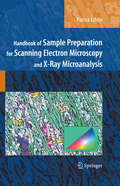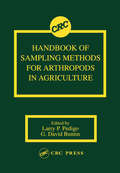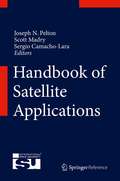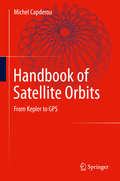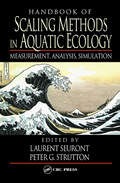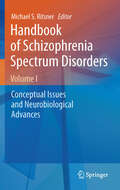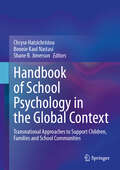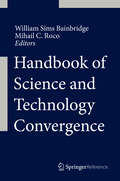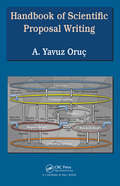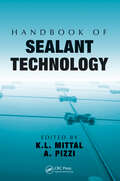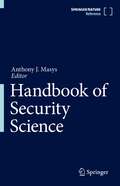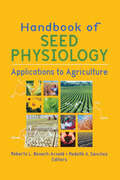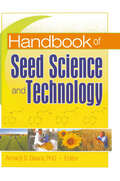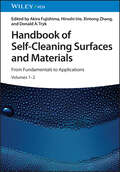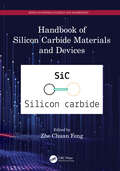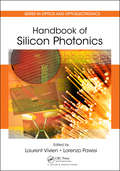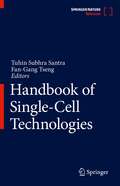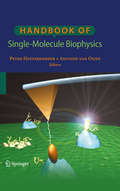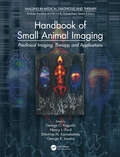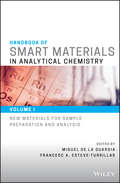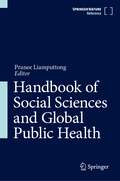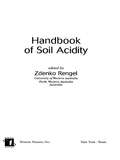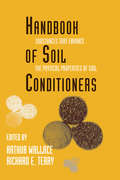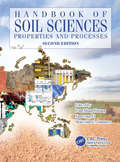- Table View
- List View
Handbook of Road Ecology
by Rodney van der Ree Clara Grilo Daniel J. SmithThis authoritative volume brings together some of the world's leading researchers, academics, practitioners and transportation agency personnel to present the current status of the ecological sustainability of the linear infrastructure - primarily road, rail and utility easements - that dissect and fragment landscapes globally. It outlines the potential impacts, demonstrates how this infrastructure is being improved, and how broad ecological principles are applied to mitigate the impact of road networks on wildlife. Research and monitoring is an important aspect of road ecology, encompassing all phases of a transportation project. This book covers research and monitoring to span the entire project continuum - starting with planning and design, through construction and into maintenance and management. It focuses on impacts and solutions for species groups and specific regions, with particular emphasis on the unique challenges facing Asia, South America and Africa. Other key features: Contributions from authors originating from over 25 countries, including from all continents Each chapter summarizes important lessons, and includes lists of further reading and thoroughly up to date references Highlights principles that address key points relevant to all phases in all road projects Explains best-practices based on a number of successful international case studies Chapters are "stand-alone", but they also build upon and complement each other; extensive cross-referencing directs the reader to relevant material elsewhere in the book Handbook of Road Ecology offers a comprehensive summary of approximately 30 years of global efforts to quantify the impacts of roads and traffic and implement effective mitigation. As such, it is essential reading for those involved in the planning, design, assessment and construction of new roads; the management and maintenance of existing roads; and the modifying or retrofitting of existing roads and problem locations. This handbook is an accessible resource for both developed and developing countries, including government transportation agencies, Government environmental/conservation agencies, NGOs, and road funding and donor organisations.
Handbook of Sample Preparation for Scanning Electron Microscopy and X-Ray Microanalysis
by Patrick EchlinThis Handbook is a complete guide to preparing a wide variety of specimens for the scanning electron microscope and x-ray microanalyzer. Specimens range from inorganic, organic, biological, and geological samples to materials such as metals, polymers, and semiconductors which can exist as solids, liquids, and gases. While the Handbook complements the best-selling textbook, Scanning Electron Microscopy and X-Ray Microanalysis, Third Edition, by Goldstein, et al., it is entirely self-contained and describes what is needed up to the point the sample is put into the instrument. Photomicrographs of each specimen complement the many sample preparation "recipes". Additional chapters describe the general features of specimen preparation in relation to the different needs of scanning electron microscopes and x-ray microanalyzers, and an appendix covers chemicals and equipment applicable to any of the recipes. This authoritative yet practical Handbook is an essential reference for anyone who uses these instruments, and assumes only an elementary knowledge of preparation techniques to guide the reader through the specific protocols.
Handbook of Sampling Methods for Arthropods in Agriculture
by Larry P. Pedigo; G. David BuntinHandbook of Sampling Methods for Arthropods in Agriculture offers a comprehensive look at the principles and practicality of developing accurate sampling programs for arthropod pests and their arthropod enemies. The book examines developments in sampling populations and reviews sampling plans that produce accurate and affordable population estimates. The text stresses practicality, as well as the theoretical background of sampling. This book will be an indispensable reference for researchers, students, and practitioners in entomology and agriculture.
Handbook of Satellite Applications
by Sergio Camacho-Lara Scott Madry Joseph N. PeltonTop space experts from around the world have collaborated to produce this comprehensive, authoritative, and clearly illustrated reference guide to the fast growing, multi-billion dollar field of satellite applications and space communications. This handbook, done under the auspices of the International Space University based in France, addresses not only system technologies but also examines market dynamics, technical standards and regulatory constraints. The handbook is a completely multi-disciplinary reference book that covers, in an in-depth fashion, the fields of satellite telecommunications, Earth observation, remote sensing, satellite navigation, geographical information systems, and geosynchronous meteorological systems. It covers current practices and designs as well as advanced concepts and future systems. It provides a comparative analysis of the common technologies and design elements for satellite application bus structures, thermal controls, power systems, stabilization techniques, telemetry, command and control (TTC), and orbital configurations. These common aspects are addressed in an integrated fashion to explain how all these space systems share similar design features, but also have quite specialized application packages to carry out their various missions. No other reference in print today provides such a comprehensive and in-depth guide to all forms of application satellites, including small sats as used by countries just beginning space application programs.
Handbook of Satellite Orbits
by Michel CapderouFifty years after Sputnik, artificial satellites have become indispensable monitors in many areas, such as economics, meteorology, telecommunications, navigation and remote sensing. The specific orbits are important for the proper functioning of the satellites. This book discusses the great variety of satellite orbits, both in shape (circular to highly elliptical) and properties (geostationary, Sun-synchronous, etc. ). This volume starts with an introduction into geodesy. This is followed by a presentation of the fundamental equations of mechanics to explain and demonstrate the properties for all types of orbits. Numerous examples are included, obtained through IXION software developed by the author. The book also includes an exposition of the historical background that is necessary to help the reader understand the main stages of scientific thought from Kepler to GPS. This book is intended for researchers, teachers and students working in the field of satellite technology. Engineers, geographers and all those involved in space exploration will find this information valuable. Michel Capderou's book is an essential treatise in orbital mechanics for all students, lecturers and practitioners in this field, as well as other aerospace systems engineers. --Charles Elachi, Director, NASA Jet Propulsion Laboratory
Handbook of Scaling Methods in Aquatic Ecology: Measurement, Analysis, Simulation
by Laurent Seuront Peter G. StruttonThe evolution of observational instruments, simulation techniques, and computing power has given aquatic scientists a new understanding of biological and physical processes that span temporal and spatial scales. This has created a need for a single volume that addresses concepts of scale in a manner that builds bridges between experimentalists and
Handbook of Schizophrenia Spectrum Disorders, Volume II
by Michael S. RitsnerA few disorders have some of the same symptoms as schizophrenia including schizoaffective disorders, schizophreniform disorder, schizotypal and schizoid personality disorders, delusional disorder, and autism (schizophrenia spectrum disorders). Since the 2000 there has been significant progress in our understanding of the early presentations, assessment, suspected neuropathology, and treatment of these disorders. Recent technological breakthroughs in basic sciences hold promise for advancing our understanding of the pathophysiology of schizophrenia spectrum disorders. This collective monograph reviewers recent researches regarding the origins, onset, course, and outcome of schizophrenia spectrum disorders. In particular, this book will be illustrate new developments in terms of conceptual models, and research methodology, genetics and genomics, brain imaging and neurochemical studies, neurophysiology and information processing in schizophrenia spectrum disorders patients. Also will be highlighted new developments in our understanding of the childhood psychosis, prodromal and first-episode states, in treatment and rehabilitation. Thus, the purpose of this book is to provide up-to-date overview of the rapid advances made in the clinical and basic science studies supporting our understanding of the relationship between cerebral processes and clinical, cognitive and other presentations of the schizophrenia spectrum disorders. In addition, this book aims to monitor important research developments, which may be relevant to treatment, and rehabilitation of patients.
Handbook of School Psychology in the Global Context: Transnational Approaches to Support Children, Families and School Communities
by Shane R. Jimerson Bonnie Kaul Nastasi Chryse HatzichristouThis handbook introduces a transnational approach to school psychology theory and practice. It provides a detailed review and analysis of multicultural and international literature in school psychology. In addition, the volume synthesizes this literature in ways that help promote transnational perspectives in the field of school psychology and recommends transnational processes that can further enhance the preparation and the role of school psychologists across a global context. With contributions from school psychology faculty members, researchers, and practitioners across diverse, multicultural, and international backgrounds, this book offers readers interested in studying or practicing school psychology in a transnational context an excellent background and introduction to the subject matter. Topical coverage ranges from conceptual foundations, educational and psychosocial foundations/systems, psychological and educational assessment, prevention and intervention, international research projects, school psychological services and training, special topics and future directions in the field. The breadth of the chapters makes this handbook a key resources for guiding and directing future research, training and practice that considers the current transnational challenges and resources of school psychology. This handbook is an essential resource for researchers, scientist-practitioners, clinicians, and graduate students in child and school psychology, social work, public health, educational policy and politics, and other school-based and child-serving mental health disciplines.
Handbook of Science and Technology Convergence
by William Sims Bainbridge Mihail C. RocoScientists and engineers have long been aware of the tension between narrow specialization and multidisciplinary cooperation, but now a major transformation is in process that will require technical fields to combine far more effectively than formerly in the service of human benefit. This handbook will catalog all the ways this can be accomplished and the reasons it must be. Nature is a single coherent system and diverse methods of scientific and engineering investigations should reflect this interlinked and dynamic unity. Accordingly, general concepts and ideas should be developed systematically in interdependence, with cause-and-effect pathways, for improved outcomes in knowledge, technology and applications. At the same time, industrial and social applications rely on integration of disciplines and unification of knowledge. Thus, convergence is both a fundamental principle of nature and a timely opportunity for human progress. This handbook will represent the culmination of fifteen years of workshops, conferences and publications that initially explored the connections between nanotechnology, biotechnology, information technology and new technologies based on cognitive science. A constant emphasis on human benefit then drew in the social sciences, even as shared scientific and ethical principles brought in sustainability of the Earth environment and the challenge of equitable economic advancement. The intellectual contributions of literally hundreds of scientists and engineers established a number of research methods and analytical principles that could unite disparate fields. The culmination has been called Convergence of Knowledge and Technology for the benefit of Society (CKTS), defined as the escalating and transformative interactions among seemingly different disciplines, technologies, communities and domains of human activity to achieve mutual compatibility, synergism and integration.
Handbook of Scientific Proposal Writing
by A.Yavuz OrucInvestigators, their home institutions, and funding agencies play significant roles in the development and outcomes of scientific projects. Submitting a proposal to a funding agency is only one dimension of a multivariable and complex funding process, and understanding this is a good first step toward unlocking the puzzle behind why some research p
Handbook of Sealant Technology
by K. L. Mittal A. PizziSealing is an age-old problem that dates back to our earliest attempts to create a more comfortable living environment. Prehistoric people used natural sealants such as earth, loam, grass, and reeds to protect the interior of their homes against the weather. Today's applications extend to a myriad of uses. The Handbook of Sealant Technology provide
Handbook of Security Science
by Anthony J. MasysThis handbook offers insights into how science (physical, natural and social) and technology can support new developments to manage the complexity resident within the threat and risk landscape.The security landscape can be described as dynamic and complex stemming from the emerging threats and risks that are both persistent and transborder. Globalization, climate change, terrorism, transnational crime can have significant societal impact and forces one to re-evaluate what ‘national security’ means. Recent global events such as mass migration, terrorist acts, pandemics and cyber threats highlight the inherent vulnerabilities in our current security posture. As an interdisciplinary body of work, the Handbook of Security Science captures concepts, theories and security science applications, thereby providing a survey of current and emerging trends in security. Through an evidence-based approach, the collection of chapters in the book delivers insightful and comprehensive articulation of the problem and solution space associated with the complex security landscape. In so doing the Handbook of Security Science introduces scientific tools and methodologies to inform security management, risk and resilience decision support systems; insights supporting design of security solutions; approaches to threat, risk and vulnerability analysis; articulation of advanced cyber security solutions; and current developments with respect to integrated computational and analytical solutions that increase our understanding of security physical, social, economic, and technological interrelationships and problem space.
Handbook of Seed Physiology: Applications to Agriculture
by Rodolfo A. Sánchez Roberto L. Benech-ArnoldThe latest findings in seed physiologydiscussed as they relate to agricultural problems! Presenting the latest findings in the area of seed physiology as well as the practical applications of that knowledge in the field, the Handbook of Seed Physiology: Applications to Agriculture provides a comprehensive view of seed biology and it
Handbook of Seed Science and Technology
by Amarjit S. BasraA reference text with the latest information and research for educators, students, and researchers!World hunger and malnutrition remain an alarming concern that spurs researchers to develop quality technology. The Handbook of Seed Science and Technology is an extensive reference text for educators, students, practitioners, and researchers that focuses on the underlying mechanisms of seed biology and the impact of powerful biotechnological approaches on world hunger, malnutrition, and consumer preferences. This comprehensive guide provides the latest available research from noted experts pointing out the likely directions of future developments as it presents a wealth of seed biology and technological information.Seed science is the all-important foundation of plant science study. The Handbook of Seed Science and Technology provides an integrative perspective that takes you through the fundamentals to the latest applications of seed science and technology. This resource provides a complete overview, divided into four sections: Seed Developmental Biology and Biotechnology; Seed Dormancy and Germination; Seed Ecology; and Seed Technology. The Handbook of Seed Science and Technology examines: the molecular control of ovule development female gametophyte development cytokinins and seed development grain number determination in major grain crops metabolic engineering of carbohydrate supply in plant reproductive development enhancing the nutritive value of seeds by genetic engineering the process of accumulation of seed proteins and using biotechnology to improve crops synthetic seeds dormancy and germination hormonal interactions during dormancy release and germination photoregulation of seed germination seed size seed predation natural defense mechanisms in seeds seed protease inhibitors soil seed banks the ecophysiological basis of weed seed longevity in the soil seed quality testing seed vigor and its assessment diagnosis of seed-borne pathogens seed quality in vegetable crops vegetable hybrid seed production practical hydration of seeds of tropical crops seed technology in plant germplasm The Handbook of Seed Science and Technology is extensively referenced and packed with tables and diagrams, and makes an essential source for students, educators, researchers, and practitioners in seed science and technology.
Handbook of Self-Cleaning Surfaces and Materials: From Fundamentals to Applications
by Akira FujishimaHandbook of Self-Cleaning Surfaces and Materials The first truly comprehensive work on this rapidly developing field in two volumes Self-cleaning surfaces are those that can be cleaned, for instance, by sun or rainwater, without human intervention. They are sometimes found in nature but developing man-made equivalents has been a major area of nanotechnology research in recent years. Self-cleaning tiles, glasses, paints, and textiles have been developed to date, and the number of applications for this technology is growing. Handbook of Self-Cleaning Surfaces and Materials provides a comprehensive overview of this field of study. It includes two volumes, with the first presenting the basic principles of the field and the second supplying specific examples and applications. It is a one-stop shop for anyone looking to familiarize themselves with this area of technological research, as well as for existing professionals who want a handy and thorough reference. Readers of the Handbook of Self-Cleaning Surfaces and Materials will also find: An editor and contributor team with decades of experience in both academic and industrial research Detailed treatment of subjects including TiO2 photocatalysis, hydrophobic self-cleaning surfaces, and more Figures throughout illustrating important concepts and chemical formulas Handbook of Self-Cleaning Surfaces and Materials is an essential resource for researchers and industry professionals in chemistry, surface physics, and materials science.
Handbook of Silicon Carbide Materials and Devices (Series in Materials Science and Engineering)
by Zhe Chuan FengThis handbook presents the key properties of silicon carbide (SiC), the power semiconductor for the 21st century. It describes related technologies, reports the rapid developments and achievements in recent years, and discusses the remaining challenging issues in the field. The book consists of 15 chapters, beginning with a chapter by Professor W. J. Choyke, the leading authority in the field, and is divided into four sections. The topics include presolar SiC history, vapor-liquid-solid growth, spectroscopic investigations of 3C-SiC/Si, developments and challenges in the 21st century; CVD principles and techniques, homoepitaxy of 4H-SiC, cubic SiC grown on 4H-SiC, SiC thermal oxidation processes and MOS interface, Raman scattering, NIR luminescent studies, Mueller matrix ellipsometry, Raman microscopy and imaging, 4H-SiC UV photodiodes, radiation detectors, and short wavelength and synchrotron X-ray diffraction. This comprehensive work provides a strong contribution to the engineering, materials, and basic science knowledge of the 21st century, and will be of interest to material growers, designers, engineers, scientists, postgraduate students, and entrepreneurs.
Handbook of Silicon Photonics (Series in Optics and Optoelectronics)
by Lorenzo Pavesi Laurent VivienThe development of integrated silicon photonic circuits has recently been driven by the Internet and the push for high bandwidth as well as the need to reduce power dissipation induced by high data-rate signal transmission. To reach these goals, efficient passive and active silicon photonic devices, including waveguide, modulators, photodetectors,
Handbook of Single-Cell Technologies
by Fan-Gang Tseng Tuhin Subhra SantraThis book provides a brief overview of single-cell analysis using recent advanced technologies. The different sections cover different aspect of single cell analysis and applications with their advantages, limitations, and future challenges. The book has covered how different physical energies such as optical, electrical, and mechanical energy have been applied for single cell therapy and analysis. The recent advanced micro/nanofluidic devices have been employed for single-cell counting, manipulation, cultivation, separation, isolation, lysis, printing and patterning and host-viral interaction at single-cell level. Various chemical approaches for single-cell analysis have been discussed, such as liposome mediated materials transfer at single-cell and their analysis, discovery of antibody via single-cell, high-throughput screening of antigen-specific antibody-secreting cells, and biomolecular secretion analysis of individual cells. Moreover, different single-cell omics such as genomics, proteomics and transcriptomics have been discussed using microfluidic technologies as well as conventional approaches. The role of single cell analysis in system biology and biocatalysis have been discussed in detail. The book describes single-cell phenotyping of heterogeneous tissue, stimulation, and instant reaction quenching technology for biochemical kinetic analysis, large scale single-cell assay for the identification of biocatalysts and analytical techniques for single-cell studies in microbiology. The role of single-cell analysis in cancer, such as single-cell adhesion and cancer progression, single-cell technologies for cancer therapy, analytical technology for single cancer cell analysis, and biophysical markers for cancer cell analysis have been discussed. The flow cytometry based high throughput single-cell analysis have been well emphasized. Finally this book has covered single-cell electrophysiology, single-cell sensing and size measurement using mechanical and microwave resonators, molecular force spectroscopy for cell adhesion measurement, micro-tweezers and force microscopy techniques for single-cell mechanobiological analysis, mass spectrometry and acoustic tweezers for single-cell manipulation and analysis. This book is intended for academic and industrial researchers, undergraduate and graduate students in the fields of biomedical engineering, bio-micro/nanoengineering, and bio-micro/nano fabrication for single-cell analysis. It can be used for courses on bio-MEMS/bio-NEMS, biomicrofluidics, bio-micro/nanofabrications, micro/nanofluidics, biophysics, single cell analysis, bionanotechnology, drug delivery systems and biomedical microdevices. Collective contributions from respected experts, have brought diverse aspects of single-cell technologies in a single hand book. This will benefit researchers and practitioners in the biotechnology industry for different diseases analysis, therapeutics, diagnostics, drug discovery, drug screening etc. In addition to hard copies, the book will be available online and will often be updated by the authors.
Handbook of Single-Molecule Biophysics
by Peter Hinterdorfer Antoine Van OijenThis handbook describes experimental techniques to monitor and manipulate individual biomolecules, including fluorescence detection, atomic force microscopy, and optical and magnetic trapping. It includes single-molecule studies of physical properties of biomolecules such as folding, polymer physics of protein and DNA, enzymology and biochemistry, single molecules in the membrane, and single-molecule techniques in living cells.
Handbook of Small Animal Imaging: Preclinical Imaging, Therapy, and Applications (Imaging in Medical Diagnosis and Therapy)
by George C. Kagadis Nancy L. Ford Dimitrios N. Karnabatidis George K. LoudosThe use of small animal models in basic and preclinical sciences constitutes an integral part of testing new pharmaceutical agents prior to their application in clinical practice. New imaging and therapeutic approaches need to be tested and validated first in animals before application to humans. Handbook of Small Animal Imaging: Preclinical Imaging, Therapy, and Applications collects the latest information about various imaging and therapeutic technologies used in preclinical research into a single source. Useful to established researchers as well as newcomers to the field, this handbook shows readers how to exploit and integrate these imaging and treatment modalities and techniques into their own research. The book first presents introductory material on small animal imaging, therapy, and research ethics. It next covers ionizing radiation and nonionizing radiation methods in small animal imaging, hybrid imaging, and imaging agents. The book then addresses therapeutic research platforms and image quantification, explaining how to ensure accurate measurements of high-quality data. It concludes with an overview of many small animal imaging and therapy applications that demonstrate the strength of the techniques in biomedical fields.
Handbook of Smart Materials in Analytical Chemistry
by Miguel de la Guardia Francesc A. Esteve-TurrillasA comprehensive guide to smart materials and how they are used in sample preparation, analytical processes, and applications This comprehensive, two-volume handbook provides detailed information on the present state of new materials tailored for selective sample preparation and the legal frame and environmental side effects of the use of smart materials for sample preparation in analytical chemistry, as well as their use in the analytical processes and applications. It covers both methodological and applied analytical aspects, relating to the development and application of new materials for solid-phase extraction (SPE) and solid-phase microextraction (SPME), their use in the different steps and techniques of the analytical process, and their application in specific fields such as water, food, air, pharmaceuticals, clinical sciences and forensics. Every chapter in Handbook of Smart Materials in Analytical Chemistry is written by experts in the field to provide a comprehensive picture of the present state of this key area of analytical sciences and to summarize current applications and research literature in a critical way. Volume 1 covers New Materials for Sample Preparation and Analysis. Volume 2 handles Analytical Processes and Applications. Focuses on the development and applications of smart materials in analytical chemistry Covers both, methodological and applied analytical aspects, for the development of new materials and their use in the different steps and techniques of the analytical process and their application in specific fields Features applications in key areas including water, air, environment, pharma, food, forensic, and clinical Presents the available tools for the use of new materials suitable to aid recognition process to the sample preparation and analysis A key resource for analytical chemists, applied laboratories, and instrument companies Handbook of Smart Materials in Analytical Chemistry, 2V Set is an excellent reference book for specialists and advanced students in the areas of analytical chemistry, including both research and application environments.
Handbook of Social Sciences and Global Public Health
by Pranee LiamputtongThis handbook highlights the relevance of the social sciences in global public health and their significantly crucial role in the explanation of health and illness in different population groups, the improvement of health, and the prevention of illnesses around the world. Knowledge generated via social science theories and research methodologies allows healthcare providers, policy-makers, and politicians to understand and appreciate the lived experience of their people, and to provide sensitive health and social care to them at a time of most need. Social sciences, such as medical sociology, medical anthropology, social psychology, and public health are the disciplines that examine the sociocultural causes and consequences of health and illness. It is evident that biomedicine cannot be the only answer to improving the health of people. What makes social sciences important in global public health is the critical role social, cultural, economic, and political factors play in determining or influencing the health of individuals, communities, and the larger society and nation. This handbook is comprehensive in its nature and contents, which range from a more disciplinary-based approach and theoretical and methodological frameworks to different aspects of global public health. It covers: Discussions of the social science disciplines and their essence, concepts, and theories relating to global public health Theoretical frameworks in social sciences that can be used to explain health and illness in populations Methodological inquiries that social science researchers can use to examine global public health issues and understand social issues relating to health in different population groups and regionsExamples of social science research in global public health areas and concerns as well as population groups The Handbook of Social Sciences and Global Public Health is a useful reference for students, researchers, lecturers, practitioners, and policymakers in global health, public health, and social science disciplines; and libraries in universities and health and social care institutions. It offers readers a good understanding of the issues that can impact the health and well-being of people in society, which may lead to culturally sensitive health and social care for people that ultimately will lead to a more equitable society worldwide.
Handbook of Soil Acidity
by Zdenko RengelThis handbook offers effective strategies to modify and adjust crop production processes to decrease the toxicity of soil contaminants, balance soil pH, improve root growth and nutrient uptake, and increase agricultural yield. The Handbook of Soil Acidity provides methods to, measure soil acidity, determine the major causes of soil acidification, c
Handbook of Soil Conditioners: Substances That Enhance the Physical Properties of Soil: Substances That Enhance the Physical Properties of Soil
by WallaceThis work features scientific, technical and practical information on mineral, organic and synthetic conditioners, as well as their beneficial effects on the soil's physical properties that promote optimal plant growth, maximize soil fertility, and enhance biomediation processes. It promotes the synergistic use of various agricultural technologies to manage global concerns of decreasing arable land.
Handbook of Soil Sciences: Properties and Processes, Second Edition (Handbook of Soil Science)
by Pan Ming Huang Yuncong Li Malcolm E. SumnerAn evolving, living organic/inorganic covering, soil is in dynamic equilibrium with the atmosphere above, the biosphere within, and the geology below. It acts as an anchor for roots, a purveyor of water and nutrients, a residence for a vast community of microorganisms and animals, a sanitizer of the environment, and a source of raw materials for co

